
To ensure a joyful and smooth travel experience, tourists often consider the environmental factors of their destination such as temperature, climate, and weather. Are you wondering about the best time to visit Thailand to embark on an unforgettable journey, indulging in its rich cultural experiences and relaxing retreats? If so, worry no more!
Why Do When You Visit Thailand Matter?
- 8 Days Bangkok & Khao Yai Ultimate Experience
- Authentic Thailand 11 Days From Mountains to the Sea
- 14 Days Discover Highlight Of South Thailand In Depth
- 14 Days Thailand to Phuket, Krabi, Chiang Mai & Bangkok
- Cultural Discovery 15 Days Tour in Thailand
- Discover Temples and Nature of Thailand in 15 Days Tour
The timing of your visit to Thailand significantly influences the experience you will have, as weather, events, and tourist crowds vary throughout the year. Visiting during the cool and dry season between November and early April offers pleasant weather, ideal for exploring beaches and outdoor attractions. However, this peak tourist season also means more crowded sites and higher prices.
Traveling in the shoulder months like May or October can provide a balance of good weather and fewer tourists. The rainy season, from June to September, offers lush landscapes and fewer crowds, suitable for cultural exploration and visiting the northern highlands, although some islands and beaches might be less accessible. Additionally, aligning your trip with local festivals like Songkran or Loy Krathong provides a unique cultural immersion, making the ‘when’ as significant as the ‘where’ in planning your Thailand journey.
Thailand Weather Overview & Best Time to Visit
Weather of Thailand
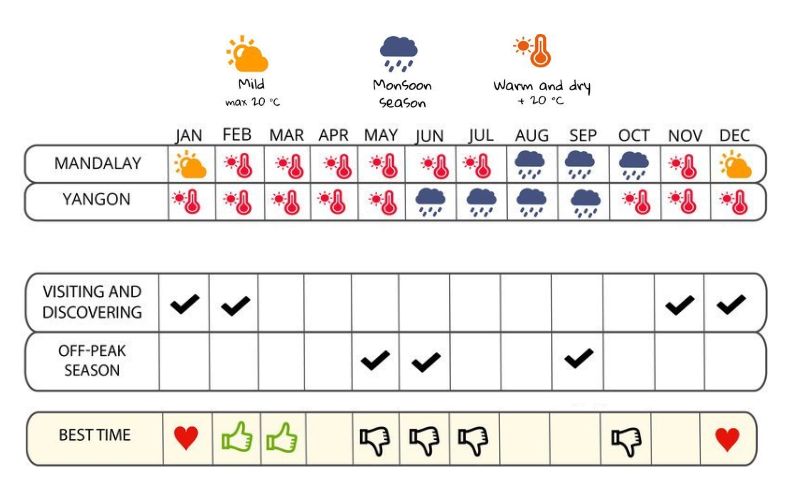
Thailand Weather
Thailand’s climate varies significantly between its northern regions and the southern peninsula, influenced predominantly by tropical and humid conditions. In the north, the year is divided into two distinct seasons, with a dry period from November to May; split further into cooler (November to February) and hotter (March to May) phases, despite not being directly affected by the northeast monsoon, cool breezes ameliorate the heat early in the year. The wet season spans from May to November, characterized by heavy rains brought by the southwest monsoon.
The country’s southern peninsula experiences just two seasons, wet and dry, with varying timings on the east and west coasts due to the southwest monsoon affecting the west coast from April to October and the east coast receiving the most rainfall between September and December. The south also sees significantly more precipitation annually compared to the central and northern regions, emphasizing the diverse climatic patterns within the country and influencing the best times to visit each region.
The Best Time to Visit Thailand
The best time to visit Thailand generally spans from November to February, during the northeast monsoon’s influence, bringing cooler, drier air that offers a break from the usual heat. This season, known as the cool season, sees temperatures in Bangkok ranging between 18 to 32 degrees Celsius, while northern parts can experience morning temperatures dropping to 8-12 degrees Celsius, sometimes even below freezing at higher elevations. The heat escalates from March to June, with Bangkok temperatures averaging around 34 degrees Celsius, and April typically marking the peak of this sweltering heat.
The monsoon season from July to October is Thailand’s wettest period, contributing the majority of its annual rainfall, and sees high humidity levels. Although termed the monsoon, this season can present varied weather patterns, not just continuous rain, and is particularly noted for heavier downpours in northern regions towards its end. This variability makes weather during these months unpredictable, impacting travel plans, especially in areas prone to flooding.
Visit Thailand In Different Seasons
The seasons in Thailand are primarily defined by variations in rainfall rather than temperature. The country’s diverse climate means that it’s suitable for travel at any time of the year. The peak tourist season is from November to February when the weather is cooler and dry. The rainy season extends from July to October, but this doesn’t deter many tourists, who enjoy activities like Thai massages, street food, and nightlife during this time.
From November to February
The duration from November to February is considered the best time to visit Thailand, when the weather is cool, dry, and sunny, with temperatures ranging from 18°C to 32°C. This period is perfect for long vacations and journeys, as it is the busiest time in Thailand. The coastal areas offer warm and pleasant weather, while the mountains and inland regions may have cooler nights, requiring a light sweater or scarf.
During this serene period, fewer traditional festivals occur, but December 5th marks the King of Thailand’s birthday, celebrated with vibrant activities in Bangkok, including beauty contests and candlelight ceremonies. From January to February, the Thai New Year and Lunar New Year bring parades, lion dances, stage performances, and fireworks, providing an unforgettable experience for visitors.
This period is also ideal for outdoor activities like exploring nature, hiking, and swimming in Thailand’s stunning beaches. It is also the best time to observe the country’s exotic wildlife, including elephants, tigers, monkeys, and birds, especially in the northern regions.

Phuket
From November to February in Thailand, visitors are encouraged to explore the beaches. Famous Thai beaches like Phuket, Pattaya, and Krabi provide an extraordinary experience with their white sandy shores, clear blue waters, golden sunshine, and a variety of dining and relaxation activities. You can stroll along the beach, relishing the clear waters and gentle waves, savor fresh seafood, partake in snorkeling to admire the beautiful coral and marine life, and take a cruise to explore pristine islands.
>>> Check out this Thailand 10 Days For Discovering Phuket & Krabi to explore the pristine and majestic natural beauty of Phuket and Krabi, complemented by their stunning beaches, making them captivating destinations.
Additionally, you can immerse yourself in two of the largest sky lantern festivals: Loy Krathong (held at the end of November in the Gregorian calendar) and Yi Peng (celebrated on the full moon of the twelfth lunar month). These festivals are renowned as the most romantic celebrations on the planet, with a mesmerizing spectacle of millions of sky lanterns lighting up the night sky, carrying the wishes of the Thai people and visiting tourists. These festivals are perfect for honeymooners, couples planning to propose, or simply for those who dream of a scene straight out of the Disney animated film “Tangled.”
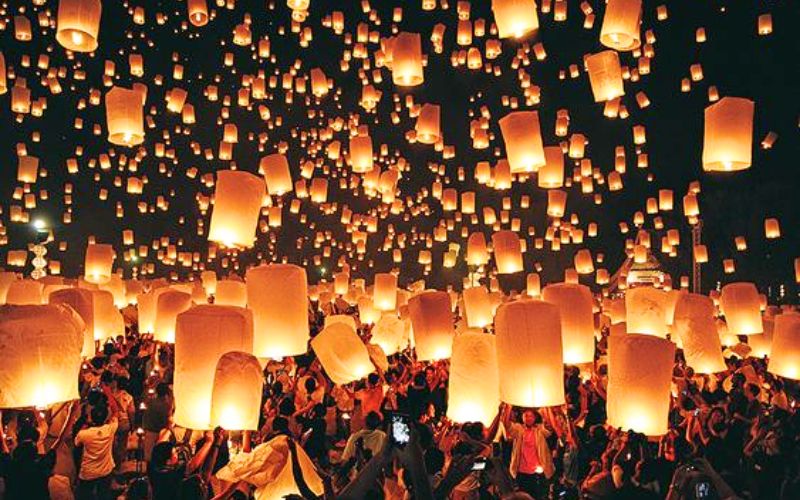
Loy Krathong & Yi Peng Festival
From March to July
From March to July, Thailand experiences its off-peak tourism season due to high temperatures (30°C to 34°C) and a dry, hot climate. This period offers fewer crowds and attractive deals on travel and accommodation, making it a popular time for students and backpackers.
Despite the heat, this time of year is lively with traditional festivals and celebrations. The Songkran festival in April is a highlight, where people engage in water fights, similar to India’s Holi festival. Getting drenched is considered auspicious, bringing good luck and peace. Tourists should armed with water guns to partake in the fun, which is complemented by cultural programs and vibrant processions through the streets.
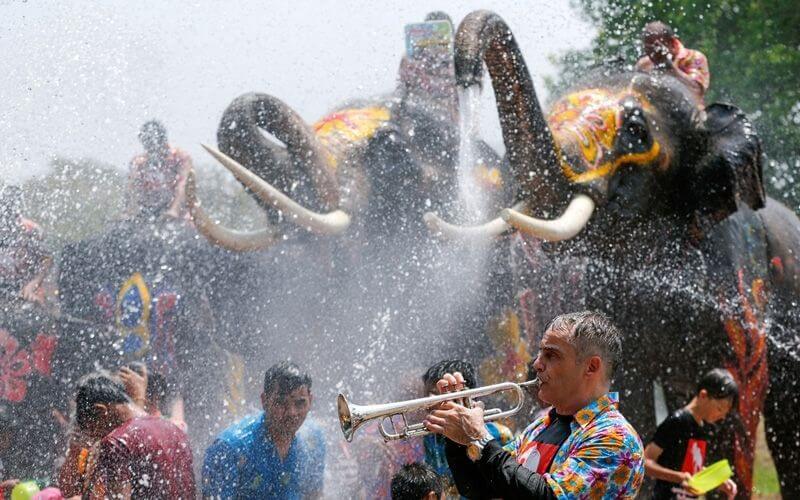
Songkran Festival
For fruit enthusiasts, May and June are the prime months to visit Thailand and partake in the Chanthaburi Fruit Festival, where you can savor an abundance of fresh fruits. In June, unwind and enjoy the smooth melodies at the Hua Hin Jazz Festival, featuring an array of Thai and international artists.
Thailand’s summer showcases its tropical climate at its finest, with clear skies, pure sea water, golden sunlight filtering through the trees, and gentle sea breezes. The beaches offer a sanctuary from the heat, where you can cool off in the clear seawater and enjoy a variety of activities. Immerse yourself in snorkeling to explore vibrant marine life, greet the sunrise with a cup of coffee, canoe in the refreshing sea breeze, discover pristine islands, stroll along the shore, indulge in thrilling water sports, or dine under the setting sun. For a sensory-filled journey, don’t miss coastal paradises like Koh Phi Phi, Phuket, Krabi, Koh Samui, Koh Phayam, and Koh Larn.
“TIP: staying hydrated, taking vitamins, wearing light-colored, loose clothing, and applying sunscreen regularly when outdoors.”
From July to October
During this time in Thailand, temperatures typically range from 23°C to 29°C, accompanied by heavy rainfall and high humidity. Despite the challenging weather, it can be an ideal time for budget-conscious travelers, as the decrease in tourist numbers leads to significantly lower accommodation and travel costs compared to the peak season.
From July to October, Thailand celebrates two major birthdays: King Maha Vajiralongkorn’s birthday on July 28th and Queen Sirikit’s birthday on August 12th, marked as Mother’s Day in Thailand. On these days, the country is vibrant with cultural programs, candle-lighting ceremonies, and fireworks displays.
Visiting Thailand from July to October offers a chance to dive into the vibrant atmosphere of the country’s unique traditional festivals. Engage in lively activities, savor special local cuisines, and immerse yourself in cultural richness.
- Phi Ta Khon Ghost Festival (June): This spiritual homage to Northeast Thailand’s traditions features participants in elaborate ghost masks and colorful costumes, reminiscent of Western Halloween.
- Rayong Fruit Festival (June and July): Celebrate the bountiful harvest and honor farmers with activities like fruit buffets, eating contests, a beauty pageant, poetry sessions, and giant fruit sculptures.
- Ubon Candle Festival (July): Marking the start of Buddhist Lent, this festival showcases a procession of intricately carved candles and wax sculptures by top artisans.
- Phuket Vegetarian Festival (October): Participants parade through the streets, performing acts of self-mortification like fasting and cheek piercing, believed to drive away evil spirits and honor protective deities.
- Chonburi Buffalo Racing Festival (October): Locals race their strongest buffaloes in a 135m sprint, symbolizing hopes for a prosperous harvest and abundant life, with participants and buffaloes dressed impeccably for a thrilling spectacle.
“Tip: Carrying umbrellas, and raincoats; preparing a pair of rain boots is advisable when venturing outdoors; avoiding visiting the beaches as the sea water becomes murky and can be dangerous for water activities.”
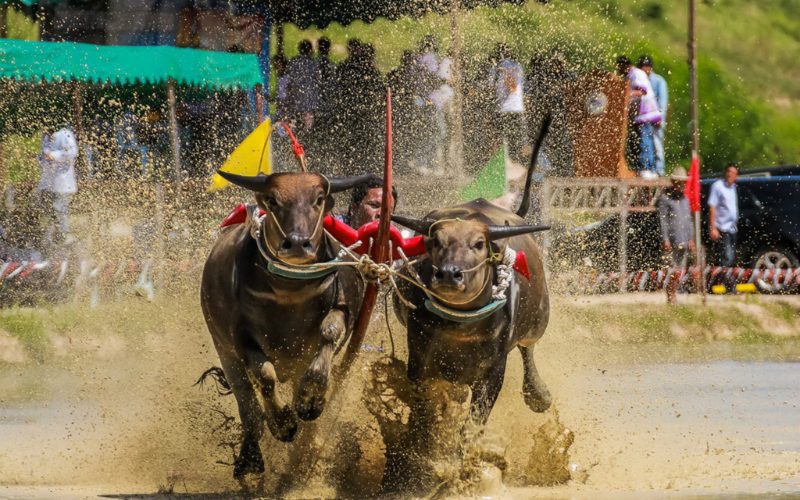
Chonburi Buffalo Racing Festival
Best Time To Visit Thailand According to Regions
Thailand is divided into six geographical regions, based on natural features including terrain and flow, as well as the cultural patterns of the people, including: the North, Northeast, Central, East, West, and South. Therefore, Thailand has different climates and weather in each region and season. The Thai tourism industry is almost developed year-round. You can travel anytime, as each season will have a region or area with a climate suitable for exploration and relaxation experiences.
Northern Thailand
The time to visit Thailand in the north is from November to February. During this period, the weather is usually cool and dry, making it ideal for sightseeing and outdoor activities. Daytime temperatures range from 20°C to 30°C, while at night they can drop below 15°C, especially in higher regions like Chiang Mai and Chiang Rai.
However, if you want to experience the Loy Krathong Lantern Festival, you should visit in November. This is one of Thailand’s biggest and most unique festivals, held on the full moon night of the 12th lunar month (usually in mid-November).
Northeast Thailand
Northeast Thailand, also known as the Isan region, has a tropical climate with three main seasons: dry, hot, and rainy. Here are some suggestions for the best time to travel to this region:
- Dry season (from November to February): This is the ideal time to travel to Northeast Thailand. The weather is cool and dry, with average temperatures ranging from 20°C to 30°C. This is also the time when many traditional festivals and cultural events take place.
- Hot season (from March to May): Temperatures can rise high, sometimes up to 40°C. However, if you can tolerate the heat, you can still visit tourist sites and enjoy local festivals such as the Songkran water festival in mid-April.
- Rainy season (from June to October): The rainy season brings significant rainfall, but it usually only lasts a few hours in the afternoon or evening. Traveling during the rainy season can be more challenging due to heavy rain and the risk of flooding, but this is also the time when the landscape becomes lush and beautiful.
Central Thailand
Central Thailand, including the capital Bangkok, and nearby provinces, can be visited year-round, but the best time to visit is from November to April, when the weather is cool and dry.
- November to February: This is the peak tourist season in Central Thailand, with cool and comfortable weather, temperatures ranging from 25°C to 30°C. This is the ideal time to visit famous tourist spots like Bangkok, Ayutthaya, and Kanchanaburi.
- March and April: The weather starts to warm up, with temperatures reaching up to 35°C or higher. However, if you don’t mind the heat, this is still a good time to visit Central Thailand, especially to experience the Songkran water festival in mid-April.
- May to October: This is the rainy season in Central Thailand, with showers and humid weather. Although the rain can disrupt some tourist activities, this is also a good time to enjoy the lush nature and visit the most beautiful waterfalls.
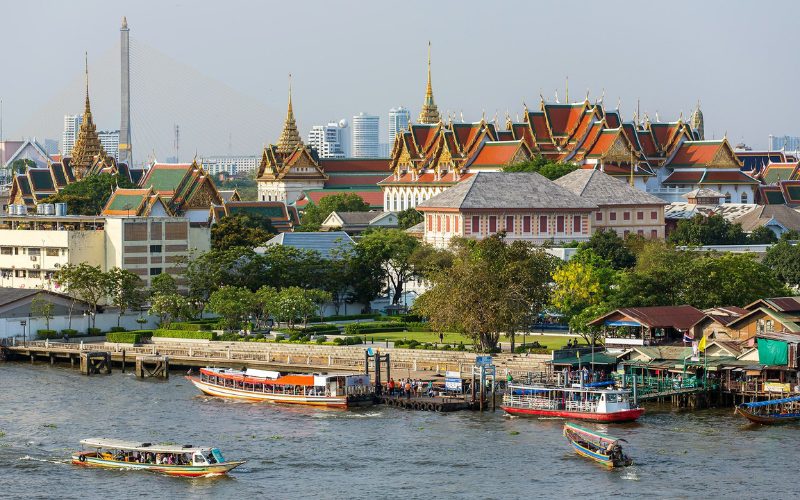
Bangkok in January
East Of Thailand
Eastern Thailand, including provinces like Chonburi, Rayong, and Trat, as well as famous islands like Koh Chang and Koh Samet, can be visited year-round. However, the best time to travel is from November to April when the weather is dry and cool.
- November to February: This is the peak tourist season in Eastern Thailand, with cool and comfortable weather, temperatures ranging from 25°C to 30°C. This is the ideal time to visit the beautiful beaches and islands.
- March and April: The weather starts to warm up, with temperatures reaching up to 35°C or higher. However, if you don’t mind the heat, this is still a good time to visit Eastern Thailand and enjoy sea activities.
- May to October: This is the rainy season in Eastern Thailand, with showers and humid weather. Although the rain can disrupt some tourist activities, this is also a good time to enjoy the lush nature and visit the most beautiful waterfalls.
Western Thailand
Western Thailand, known for areas such as Kanchanaburi and the mountainous regions near the border with Myanmar, can also be visited year-round. However, the best time to travel is from November to April when the weather is dry and cool.
- November to February: This is the peak tourist season in Western Thailand, with cool and comfortable weather, temperatures ranging from 25°C to 30°C. This is the ideal time to visit historical sites, and natural attractions, and participate in outdoor activities such as trekking and visiting waterfalls.
- March and April: The weather starts to warm up, with temperatures reaching up to 35°C or higher. However, if you don’t mind the heat, this is still a good time to visit Western Thailand and enjoy river activities such as kayaking and swimming.
- May to October: This is the rainy season in Western Thailand, with showers and humid weather. Although the rain can disrupt some tourist activities, this is also a good time to enjoy the lush nature and visit the most beautiful waterfalls.
Southern Thailand
Southern Thailand has two main climate seasons: the rainy season and the dry season. The best time to visit Thailand in southern is during the dry season, from December to April. During this period, the weather is usually dry and sunny, making it ideal for beach activities, diving, and other outdoor activities.
- December to February: The weather is cool and comfortable, with temperatures ranging from 25°C to 30°C. This is also the peak tourist season, so popular tourist destinations like Phuket, Krabi, and Koh Samui can be crowded.
- March and April: The weather starts to get warmer, with temperatures reaching up to 35°C. However, this is still a good time to visit the beautiful beaches and islands of southern Thailand.
“Tip: If you want to avoid the crowds and enjoy more affordable prices, you can consider traveling in May or November when the tourist season starts or ends. However, note that the rainy season begins in May and lasts until November, so there may be showers and unpredictable weather.”
To some extent, the best time to visit Thailand hinges on your schedule and preferences. While Thailand’s rainy season doesn’t equate to constant downpours like those seen in some other monsoon-impacted regions, and while tourist crowds tend to be substantial, they are typically manageable. However, identifying the best time for your visit also involves reflecting on your interests and the specific regions you wish to explore. Whether you’re drawn to the vibrant festivals, tranquil beaches, or lush landscapes, understanding the seasonal nuances can enhance your experience. That said, the essence of your journey should revolve around the unique destinations and experiences Thailand offers, rather than a rigid focus on timing.
Contact us right now if you still have any questions or want a tailor-made trip to Thailand. Before that, don’t forget to check our well-planned Thailand tours for more travel ideas.
Read more:



